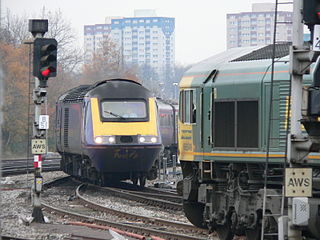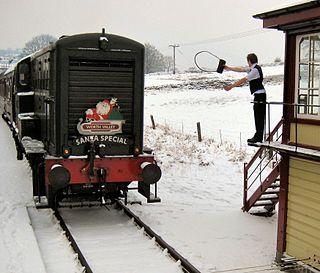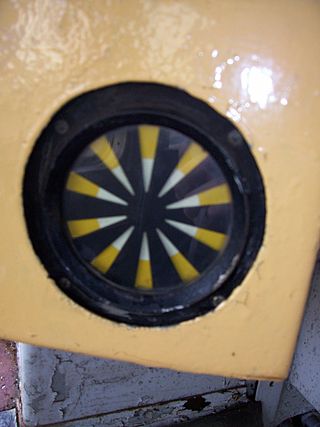
Railway signalling (BE), or railroad signaling (AE), is a system used to control the movement of railway traffic. Trains move on fixed rails, making them uniquely susceptible to collision. This susceptibility is exacerbated by the enormous weight and inertia of a train, which makes it difficult to quickly stop when encountering an obstacle. In the UK, the Regulation of Railways Act 1889 introduced a series of requirements on matters such as the implementation of interlocked block signalling and other safety measures as a direct result of the Armagh rail disaster in that year.

The Welsh Highland Railway is a 25-mile (40.2 km) long, restored 1 ft 11+1⁄2 in narrow gauge heritage railway in the Welsh county of Gwynedd, operating from Caernarfon to Porthmadog, and passing through a number of popular tourist destinations including Beddgelert and the Aberglaslyn Pass. At Porthmadog it connects with the Ffestiniog Railway and to the short Welsh Highland Heritage Railway. In Porthmadog it uses the United Kingdom's only mixed gauge flat rail crossing.

On trains, the expression emergency brake has several meanings:

In railway signalling, a token is a physical object which a train driver is required to have or see before entering onto a particular section of single track. The token is clearly endorsed with the names of the section to which it belongs. A token system is more commonly used for single lines because of the greater risk of collision in the event of a mistake being made by a signaller or traincrew than on double lines.

Automatic Warning System (AWS) is a railway safety system invented and predominantly used in the United Kingdom. It provides a train driver with an audible indication of whether the next signal they are approaching is clear or at caution. Depending on the upcoming signal state, the AWS will either produce a 'horn' sound, or a 'bell' sound. If the train driver fails to acknowledge a warning indication, an emergency brake application is initiated by the AWS. However if the driver correctly acknowledges the warning indication by pressing an acknowledgement button, then a visual 'sunflower' is displayed to the driver, as a reminder of the warning.

Radio Electronic Token Block is a system of railway signalling used in the United Kingdom. It is a development of the physical token system for controlling traffic on single lines. The system is slightly similar to North American direct traffic control, which unlike RETB does not have a cab display unit.

The Abermule train collision was a head-on collision which occurred at Abermule, Montgomeryshire, Wales on Wednesday 26 January 1921, killing 17 people. The crash arose from misunderstandings between staff which effectively over-rode the safe operation of the Electric Train Tablet system protecting the single line. A train departed carrying the wrong tablet for the section it was entering and collided with a train coming the other way.

Absolute block signalling is a British signalling block system designed to ensure the safe operation of a railway by allowing only one train to occupy a defined section of track (block) at a time. Each block section is manually controlled by a signalman, who communicates with the other block sections via telegraph. This system was used on double or multiple lines where use of each line is assigned a direction of travel before the introduction of track circuits, and is still used on many lines to this day.

The railway signalling system used across the majority of the United Kingdom rail network uses lineside signals to control the movement and speed of trains.
Australian railway signalling varies between the States of Australia, because the individual States are responsible for the railway systems within their own borders, with, historically, no need to co-ordinate between states except at the boundaries.

Signalling block systems enable the safe and efficient operation of railways by preventing collisions between trains. The basic principle is that a track is broken up into a series of sections or "blocks". Only one train may occupy a block at a time, and the blocks are sized to allow a train to stop within them. That ensures that a train always has time to stop before getting dangerously close to another train on the same line. The block system is referred to in the UK as the method of working, in the US as the method of operation, and in Australia as safeworking.

Metlink's Kapiti Line is the electrified southern portion of the North Island Main Trunk railway between New Zealand's capital city, Wellington, and Waikanae on the Kāpiti Coast, operated by Transdev Wellington on behalf of Greater Wellington Regional Council. Trains run frequently every day, with stops at 16 stations. Until 20 February 2011 it was known as the Paraparaumu Line.

Japanese railway signals, according to the ministerial decree defining technical standards of railways, are defined as indicating operational conditions for railway staff driving trains.

The Kangra Valley Railway is a 2 ft 6 in gauge railway that runs from Pathankot, Punjab to Jogindernagar in Himachal Pradesh. It runs through the sub-Himalayan region of Kangra Valley and is 164 km (101.9 mi) long. It is on the UNESCO World Heritage Sites tentative list. The railway is part of the Firozpur division of Northern Railway. It is the longest Narrow Gauge line in India and also the longest 2 ft 6 in Gauge Railway in the World. The highest point on this line is Ahju station at an elevation of 1,290 meters (4,230 ft). There are 33 stops and 950 bridges.
The Battersea Park rail crash occurred on 2 April 1937, just south of Battersea Park railway station on the Southern Railway, in London, England. Two electrically driven passenger trains collided on the Up Local line; the second train, from Coulsdon North to Victoria, had been allowed into the section while it was still occupied by the first train, from London Bridge to Victoria. The signalman at Battersea Park, G. F. Childs, believing there was a fault with the Sykes electromechanical interlocking apparatus which was installed at the box, had opened up the case of the instrument and inadvertently cleared the interlock which should have prevented this situation. The official enquiry ruled that he subsequently accepted the Coulsdon train, although he should have been aware that the London Bridge train had not cleared the section. Ten people were killed, including the guard of the London Bridge train, and eighty people were injured, seven sustaining serious injuries. Another accident had occurred at Battersea Park in 1881.

The Midland and South Western Junction Railway (M&SWJR) was an independent railway built to form a north–south link between the Midland Railway and the London and South Western Railway in England, allowing the Midland and other companies' trains to reach the port of Southampton. The M&SWJR was formed in 1884 from the amalgamation of the Swindon, Marlborough and Andover Railway and the Swindon and Cheltenham Extension Railway. The line was absorbed by the Great Western Railway at the 1923 grouping of the railways, and became part of British Railways on nationalisation in 1948. The railway closed to passengers in 1961, and to goods between 1964 and 1970. A small part of it has been reopened as the heritage Swindon and Cricklade Railway.

The application of railway signals on a rail layout is determined by various factors, principally the location of points of potential conflict, as well as the speed and frequency of trains and the movements they require to make.

The Rakaia railway accident at Rakaia, Canterbury, New Zealand on the evening of Saturday, 11 March 1899 occurred when the second of two excursion trains returning from Ashburton to Christchurch ran into the rear of the first at the Rakaia Railway Station, killing four passengers. While due to excessive speed, the accident resulted in overdue improvements by New Zealand Railways to signalling and braking.
Railway signalling in New Zealand consists of a number of signalling technologies on the national rail network and local light rail systems.
























